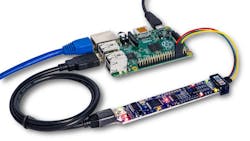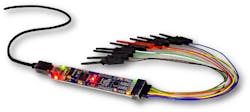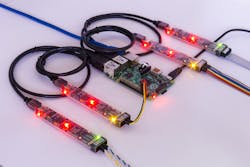The Raspberry Pi has become an extremely popular development platform (see “Arduino, Raspberry Pi or BeagleBone?”). It can run Linux and hooks up to displays and Ethernet networks. The latest incarnation has four USB ports.
One of the things to plug into the USB is BitScope's BitScope Micro (Fig. 1). The BitScope Micro is an all-in-one development tool that includes a 6 channel logic analyzer as well as a 2 channel analog scope. It has a 20 MHz bandwidth and is able to capture digital signals at 40 Msamples/s . The analog scope has 8- and 12-bit sample resolution. There are two analog comparators that can generate logic data.
The logic analyzer can decode standard protocol data streams for interfaces like SPI, I2C, CAN and more. The system can also generate analog and digital waveforms. The latter is a handy clock source.
Not enough channels? Just grab three more and plug them into the other USB ports (Fig. 2).
The BitScope Micro works with Windows, Linux, Mac OS X and the Raspberry Pi. I tried it with Fedora Linux and Rasberry Pi. I did not get a chance to check out the user programmable features but there is an API available for C/C++, Python, and VM for controlling the BitScope Micro from an application.
The BitScope Micro is small and light, only 12 grams. It contained in a clear, heat shrink tube that makes it slightly water resistant but water is not a nice mix with electronics. This is especially true for the 10-pin header at one end. This has a pair of ground lines, the two analog inputs for the oscilloscope and six digital inputs for the logic analyzer.
The BitScope Micro box includes a set of clips that plug into the header. If you want to use other probes then you will need to pick up one of the other cables. BitScope has a range of products with the BitScope Micro being at the low end.
The Raspberry Pi can be a host but I was also able to use the BitScope to check out the exposed interfaces on the Raspberry Pi itself. There is no problem checking out the protocols for other interfaces since the BitScope has its own processor and interfaces via USB.
The BitScope is handy for small, lower speed applications. It is obviously not for dealing with faster USB or PCI Express but it is significantly less expensive. It is also ideal for working with the peripheral interfaces like SPI and I2C. I could have used this when I was interfacing a camera chip to another micro.
Getting started was a download exercise. There are multiple applications available although the DSO (digital scope) logic analyzer program is the main one. It can show the analog and digital inputs on the same screen as well as decoding data streams from digital interfaces like I2C. There are other tools as well such as a spectrum analyzer.
There is a touch screen interface for DSO called Act On Touch. It can be used remotely via VNC on devices like smartphones. The interface buttons are large to allow finger control on suitable devices.
It is possible to use the system remotely. This is one reason to combine the BitScope with the Raspberry Pi even if the latter is not part of the system under test. There are actually two ways of doing this. One is to run an application DSO on the Raspberry Pi and use VNC to remotely access the system. A better way is to use the BitScope server software. The application on the PC can access the BitScope Micro via the BitScope server link. The server can handle multiple devices.
BitScope has other alternative if you need more bandwidth, signals or other features not found in the $149 BitScope Micro. For example, the BitScope 10 (BS10) has a 100 MHz bandwidth and 8 digital channels along with two analog scope inputs. The BS445 has 8 analog inputs and 8 digital inputs. These are more expensive and come in a box.
You can pick up a BitScope Micro at Newark Element14.
About the Author
William Wong Blog
Senior Content Director
Bill's latest articles are listed on this author page, William G. Wong.
Bill Wong covers Digital, Embedded, Systems and Software topics at Electronic Design. He writes a number of columns, including Lab Bench and alt.embedded, plus Bill's Workbench hands-on column. Bill is a Georgia Tech alumni with a B.S in Electrical Engineering and a master's degree in computer science for Rutgers, The State University of New Jersey.
He has written a dozen books and was the first Director of PC Labs at PC Magazine. He has worked in the computer and publication industry for almost 40 years and has been with Electronic Design since 2000. He helps run the Mercer Science and Engineering Fair in Mercer County, NJ.
- Check out more articles by Bill Wong on Electronic Design
- Bill Wong on Facebook
- @AltEmbedded on Twitter


